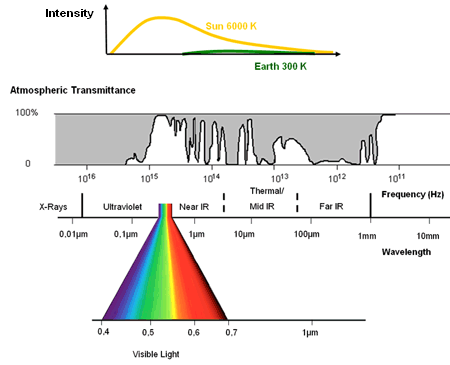1. Physical Basics
Atmospheric influences
All radiation is influenced by the atmosphere in various ways. The sun's radiation is scattered, reflected or absorbed by particles in the atmosphere as is the earth's reflected radiation. Clouds are the worst interference for radiation and make it impossible for passive satellite sensors to measure the Earth's surface.
Atmospheric influences are wavelength dependend. In the range of visible light were the sun emits highest intensities, atmospheric transmittance is the highest (see figure). In the range of higher wavelengths transmittance is reduced to narrow bands. This includes the optical windows in the thermal infrared, where the Earth's surface emits radiation. In the range of microwaves the atmosphere is nearly transmissive, but the sun and earth's radiation are low; therefore, this range is used by active radar systems. Wavelengths smaller than the ultraviolet are nearly totally absorbed by the atmosphere and are therefore less relevant for remote sensing. Remote sensing concentrates on the transmissive ranges, the so called atmospheric windows.
Atmospheric scattering denotes the diffusion of radiation by particles in the atmosphere.
Rayleigh scattering is a diffuse scattering caused by tiny particles and molecules (like nitrogen or oxygen) smaller in diameter than the wavelength of the interacting radiation. Short wavelengths of the sunlight are more intensely scattered than radiation at longer wavelengths.
Rayleigh scatter is also causing "haze" and contrast reductions on images. In colour photographs it leads to a bluish-grey cast on an image.
Mie scattering is caused by particles in the atmosphere which are larger in diameter than the considered radiation wavelengths. These are water droplets in clouds, ice crystals or aerosols (sea salt, dust, biological material, sulphate, nitrate etc. from vaporisation, fire and forest fires, volcanic eruptions and industry). The scattering is less wavelength selective than Rayleigh scattering which explains the white colour of clouds, and the grey appearance of dust.
In contrast to scattering, absorption means an effective loss of radiative energy and is mostly caused by water vapour, carbon dioxide and ozone. The absorption of all gases strongly depends on the wavelength and determines the atmospheric windows, i.e. the range of non-blocked spectral regions.
Two major aspects must be considered for any remote sensing task: The primary sources of electromagnetic radiation (sun and earth) and the atmospheric windows. Specific information is needed to select the spectral sensitivity of sensors used to detect and record radiation (see figure).

